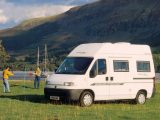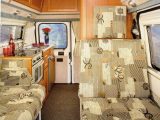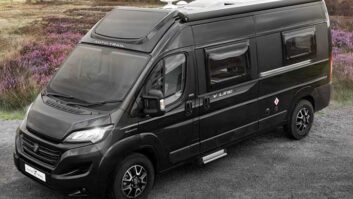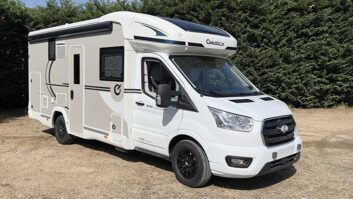Bessacarr started in Mexborough, West Yorkshire, as an independent manufacturer of coachbuilt motorcaravans. During the 1990s and as part of an expansion plan, Swift took over the marque, which could then broaden its range and enter volume panel-van conversions.
The revitalised ‘Bessie’ unveiled two initial Bessacarr E300 Series models in late 1997. Soon thereafter, a third was added and production continued until the Ducato was facelifted for 2004.
All were built on short- or medium-wheelbase Ducato tin-tops, to which the Swift Group’s GRP high-top was bonded. The result was a full-standing height within a compact footprint. Swift Group’s expertise in building touring caravans and motorhomes and the resulting cross-fertilisation of skills, fittings and ideas produced a brilliant trio.
The Bessacarr E350 was clearly aimed at capturing sales from Auto-Sleepers’ more established Symphony and Symbol; Bessacarr had copied their rear-offside kitchen, washroom and wardrobe opposite. The forward lounge got an inward-facing settee, a nearside travel seat and cab seats. The somnolent had a choice of two longitudinal single-beds or a double bed that was fiddly to make up.
The Bessacarr E370 was more revolutionary in its approach because it offered a lovely triple-aspect rear lounge which converted easily into a double bed. Just back up to the view and open the rear doors. The kitchen and washroom flank the aisle amidships.
The maverick among them was the Bessacarr E330. This consisted of a typical Volkswagen campervan layout (offside run of furniture together with a rock-and-roll double rear travel seat/bed) transferred into a much wider base vehicle. E330 is the only model without a washroom, plus it suffered from a reduced spec because it was believed that its residential duties would be limited to the summer, so no space or water heating was fitted.
It did, however, safely seat four so it could be used as a car. It’s strange, then, that it only had a double bed, though it was large.
Motive power was usually courtesy of the smooth and refined 2.0-litre petrol motor in the Bessacarr E330 and of the spirited Sofim-built 1.9-litre turbo-diesel as standard in the other two. There are a few with the larger 2.5-litre/2.8-litre naturally aspirated diesel engines.
What to look out for
First of all, when it comes to the Bessacarr’s base vehicle, although Fiat was streets ahead of most in the efficacy of its body anti-corrosion treatment, it is worth checking carefully for corrosion. Look for a low-mileage example with a full service history. Ensure that the drive belts have recently been changed. This generation had a habit of dropping fifth gear. It’s not a pricey repair, the ’van can still be driven and the ’box need not be removed.
The Bessacarr E350, E370 and, to a lesser extent, the E330 were bought by couples and empty-nesters, so they were often used with care. Those on hire fleets may look tired. Budget for a complete overhaul of all appliances.
Most Carver heater spares are still available, so don’t agree immediately to costly replacements from another manufacturer. Check around window and rooflight frames inside for water ingress.
We have helpful advice on how to mend a motorhome water filler and filter, how to upgrade motorhome lighting, reduce condensation and plenty more advice to keep older motorhomes in good shape.
Likes and dislikes
So, to sum it all up what do we like and dislike about the 1997-2002 Bessacarr E300 Series of campervans?
Likes
- Small footprint
- Classy conversion
- 1.9-litre TD is a bell-ringer!
- Coachbuilt-style luxury
Dislikes
- Standard-height habitation doors (duck or grouse!)
- Black bumpers discolour
Buying essentials
The Bessacarr E330, Bessacarr 350 and Bessacarr 370 were all based on short or medium wheelbased (SWB or MWB) Fiat Ducato vans and were converted between 1997 and 2003 by the Swift Group. These Bessacarr models have a steel body with a GRP high-top roof.
The overall length of the Bessacarr E330 is 5.01m (16’ 5.25”), while the Bessacarr E350 and 370 are both 5.19m (17’ 0.5”) long.
Which would we choose? If you prefer double beds, the rear-lounge Bessacarr E370 would be our choice. Consider your intended travel companions, though, because the E370 doesn’t have rear belted seats.
The Bessacarr E350 has one belted passenger seat in the rear and only the Bessacarr E330 has two belted seats in the back.
The Bessacarr E330 makes the best all-purpose daily ’van because it has the biggest area of uncluttered floor and the largest double-bed. The E330 is also better for wheelchair users, because it accepts a ramp and clamps more readily than its siblings.
How much should you expect to pay for a 1997-2002 Bessacarr E300 Series campervan? As a guide, quite a few high-milers are available from £10,000.
If you can stretch to £14,000 this could buy you a mint 1.9-litre TD E350/E370 with 60,000 or less on the clock. Bessacarr E330 models tend to cost £1200-£1500 less for the same year. Browse through the Practical Motorhome classified adverts to see more used Bessacarr motorhomes for sale.
Alternatively, you could consider buying the badge-engineered Swift Mondial, based on the Fiat Ducato, or the Auto-Sleepers Symphony or Symbol, built on a Peugeot Boxer base.
The Bessacarr E370 offered a lovely triple-aspect rear lounge which converted easily into a double bed















